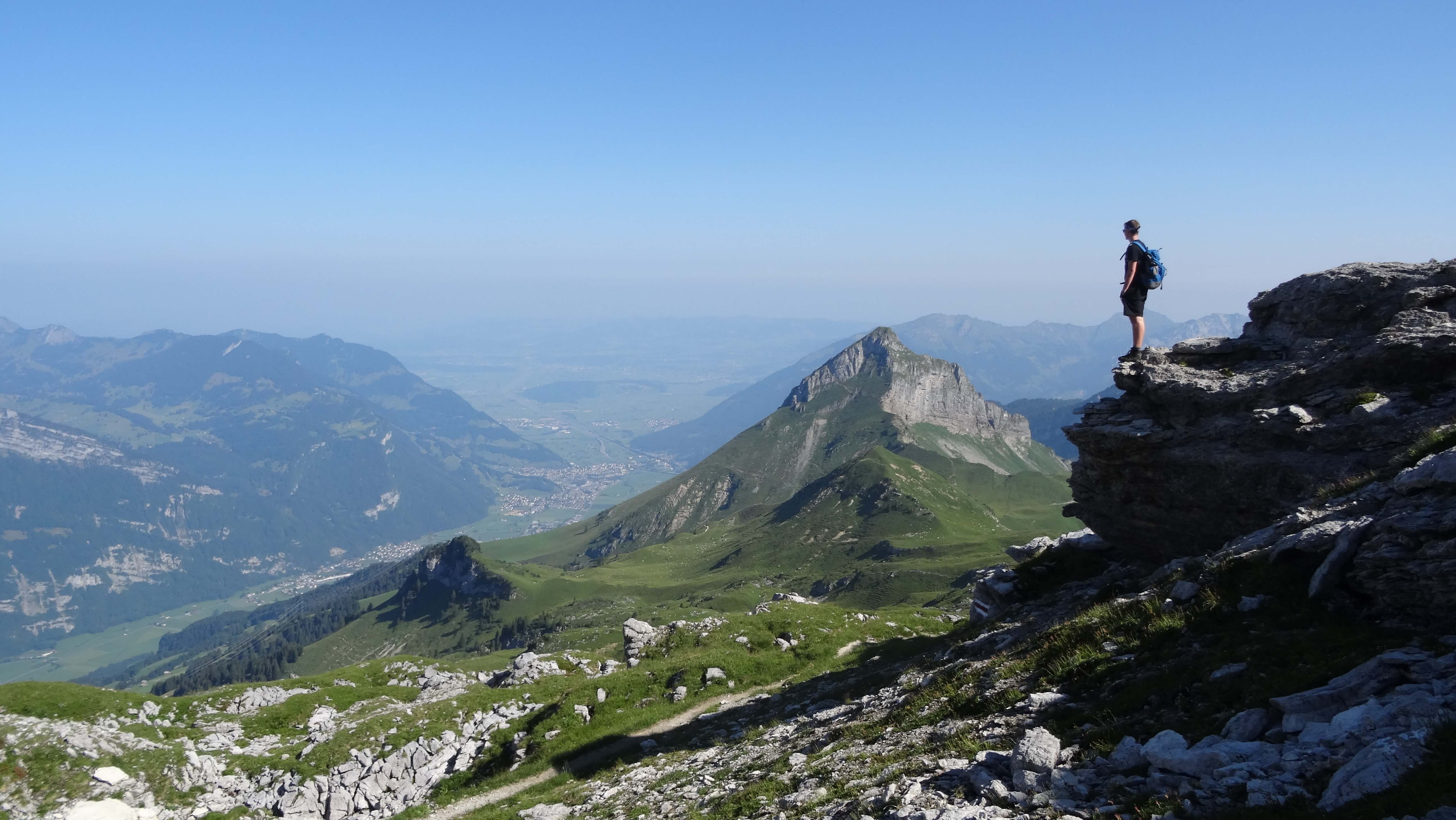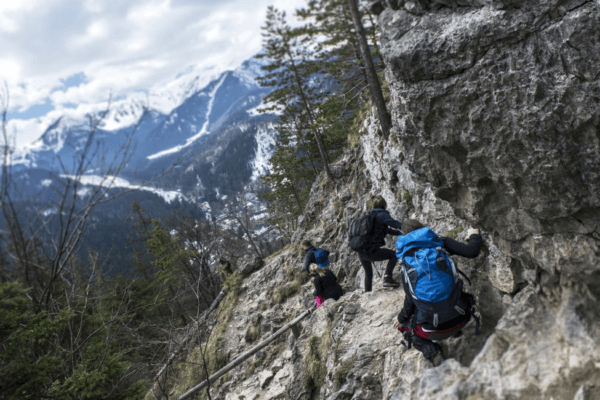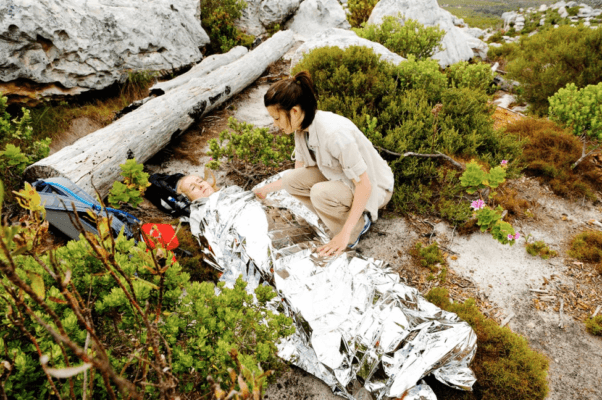Mountain hiking is an activity accessible to all and allows you to discover varied and impressive landscapes.
Following unfamiliar paths, which can be isolated or steep, can lead to an accident without a minimum of vigilance.
Before assaulting the mountains, it is essential to know and respect specific safety instructions. This is the purpose of this article on hiking safety.
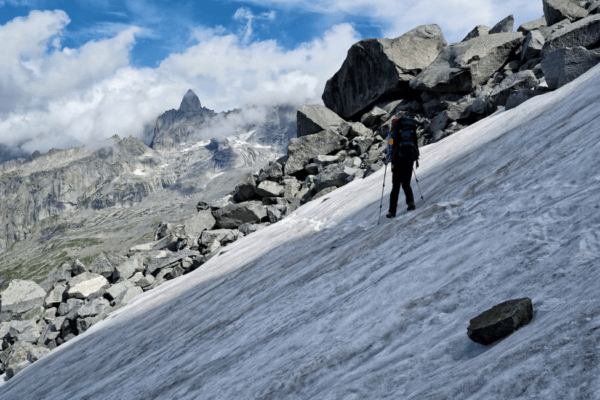
After carefully preparing your hike and being well equipped, you have been walking on a mountain path for some time now. Everything is going well. To continue like this, stay focused.
To maintain your physical performance and concentration, hydrate and feed yourself regularly, take breaks.
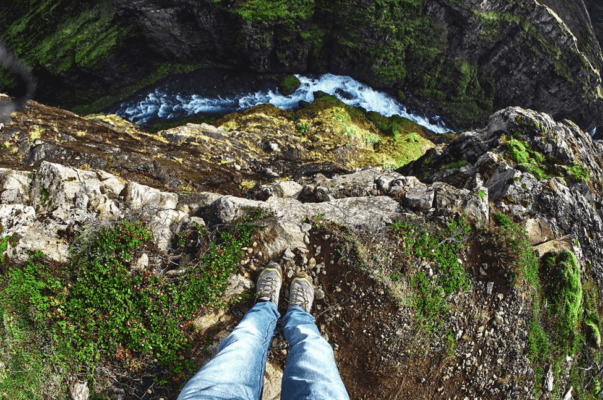
Every year, accidents - sometimes tragic - occur during mountain hikes. In most cases, hikers slip or stumble, and fall. Therefore, be particularly careful in exposed areas, e. g. on steep slopes or when crossing a steep corridor. In exposed areas, it is essential to:
As you descend, the risk increases: the movement is more demanding for the muscles and coordination, you start to feel fatigue, and concentration decreases.
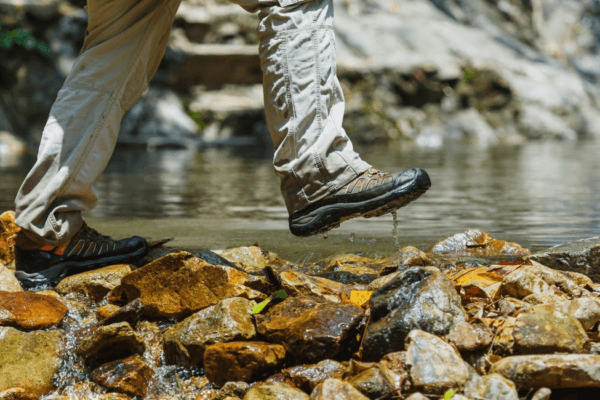
The risk of accidents occurring is high in wet or icy passages, as well as on residual (snowy) fields.
Wet, snowy or icy paths are slippery. Pay particular attention to stones, lichens, wooden elements or roots.
It is not uncommon for mountain paths to cross fields of residual snow (also called neve or firn) even in summer. When the snow is frozen and therefore hard, it is almost impossible to stop when you start sliding - with a risk of fatal outcome. In autumn, many shaded paths are icy all day long.

When choosing your itinerary, it is essential to take into account the information and warnings relating to rockfalls. Also, if part of the path is closed or conditions are poor, it is preferable to choose another route.
Also, take into consideration the weather of the last few days. Indeed, the risk of falling rocks is higher due to heavy rains or sudden changes in temperature (e. g. between freezing and melting).
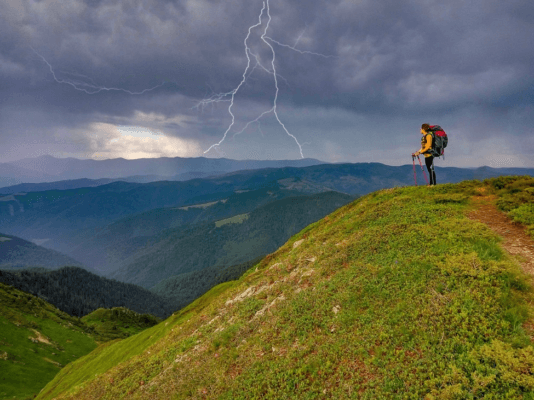
The best protection against storms is proper preparation of the hike, taking into account the weather forecast and, if necessary, the interruption of the hike in time. If you are nevertheless surprised by a storm, observe the following instructions.


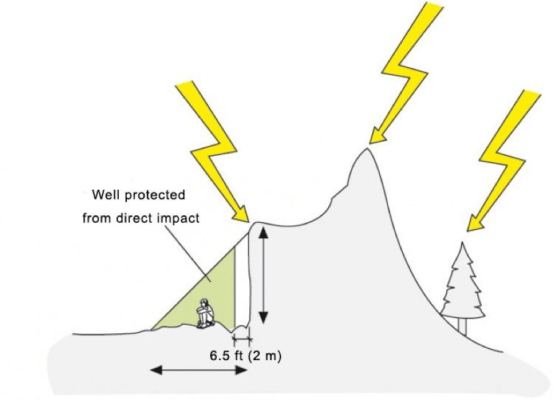
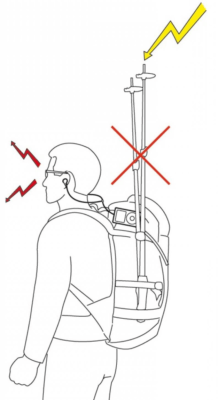
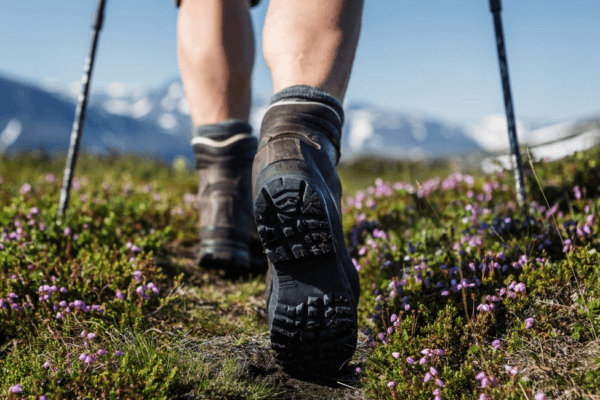
When hiking in the mountains, walk at a regular pace, not too fast. If you continuously vary the speed, you get tired quickly and can enjoy the landscape less. If there is a risk of falling into the void, concentrate fully on the path.
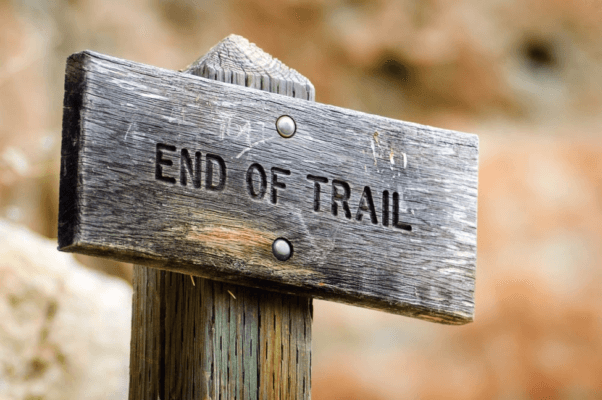
Back from the mountains, you can continue to work for safe hiking. First, don't forget to inform your family and friends of your return. You can also share your experience of the trail you have followed with other hikers. Preparation, difficulties encountered and any information you deem necessary, detail your hike on forums, on a blog so that other hikers can benefit from your experience.
 Lara Sein is a blogger, mountain guide, rock climber and outdoor enthusiast. You can find her online at OutdoorsWithNoLimits.com
Lara Sein is a blogger, mountain guide, rock climber and outdoor enthusiast. You can find her online at OutdoorsWithNoLimits.com
Following unfamiliar paths, which can be isolated or steep, can lead to an accident without a minimum of vigilance.
Before assaulting the mountains, it is essential to know and respect specific safety instructions. This is the purpose of this article on hiking safety.
Control

Everything's still okay along the way?
After carefully preparing your hike and being well equipped, you have been walking on a mountain path for some time now. Everything is going well. To continue like this, stay focused.
With fatigue, the foot is less safe.
To maintain your physical performance and concentration, hydrate and feed yourself regularly, take breaks.
- Take regular breaks, i.e. every 1 hour to 1½ hour, and every time your concentration drops. During these moments of rest, enjoy the view, recover from the effort and regain your strength.
- Hydrate yourself a lot, even if you are not thirsty.
- Cereal bars, dried fruit or grape sugar are quick sources of energy in the event of a drop in blood sugar levels.
- Are you planning to eat in a mountain refuge? So enjoy yourself, but drink alcoholic beverages in moderation.
- Small steps and a regular walking pace save strength when climbing and protect joints when descending.
Make sure you stick to your schedule and monitor the weather.
- Check your position regularly to see if you are on schedule. This will allow you to choose another route, shortcut, hike interruption or any alternative path in time.
- If the weather suddenly deteriorates, turn around soon enough or take cover. If storm clouds form, stop the hike as quickly as possible.
Do not leave the marked paths.
- Stay on the official hiking trails even if the tracks look like shortcuts. Many of other "paths" are not maintained or can end in dead ends.
- If you have lost your way, stay in a group and return to the last known point. Wait until you have better visibility or seek help.
If necessary, turn around in time.
- In case of sudden discomfort or other difficulties, do not take any risks and do not go beyond your strength. Turn around in time.
Other tips:
- Grass, snow or steep scree slopes are safer to climb than to descend. Avoid snowfields if possible.
- If you are hiking in a group, keep an eye on everyone in the group and regularly make sure that the lasts do not lose too much ground or wait for them.
- Walk calmly around the herds and at a sufficient distance. Keep the dogs on a leash.
- If you encounter sheepdogs, stay calm so that the dog understands that you are not a threat to the herd. Circle the pack from a distance.
- Let the mountain bikers through without unnecessarily hindering their progress. Peaks, ridges, raised places. Isolated trees, electrical pylons or ski lift pylons and their surroundings.
Risk of Falling In Exposed Areas

Every year, accidents - sometimes tragic - occur during mountain hikes. In most cases, hikers slip or stumble, and fall. Therefore, be particularly careful in exposed areas, e. g. on steep slopes or when crossing a steep corridor. In exposed areas, it is essential to:
- focus on the path
- watch where you step and be sure you're stable
- do not walk too fast
- do not take too big a step
- do not get distracted by a conversation
- stop if you want to take pictures, make a video or admire the scenery
- hold on to the guardrail, chain or rope if there are any
- in case of fatigue, take a break before the exposed passage
- turn around or take the alternative route planned if you are not sure you can cross the exposed passage
On The Way Down
How to behave?
As you descend, the risk increases: the movement is more demanding for the muscles and coordination, you start to feel fatigue, and concentration decreases.
Tips & Advice to avoid accidents:
- Allow enough time and save energy for the descent.
- Reduce your pace and take breaks.
- Control your supports well. Slightly tilt your torso forward and bend your knees.
- To limit shocks, cushion each step or walk with trekking poles. If used correctly, they can be beneficial.
- If necessary, opt for an easier variant on the descent.
Slippery Places

What is the right behavior to adopt?
The risk of accidents occurring is high in wet or icy passages, as well as on residual (snowy) fields.
Be careful in slippery places
Wet, snowy or icy paths are slippery. Pay particular attention to stones, lichens, wooden elements or roots.
The following points are essential:
- be well informed about the weather and route conditions
- wear sturdy hiking boots with a profiled sole
- concentrate and watch where you step
- not be distracted by discussions
- set foot with confidence
- do not walk too fast
- do not take too big a step
- hold on to the guardrail, rope, chain or any other device similar to the passages equipped with it
- turn back or take an alternative route defined in advance in front of a slippery place that does not inspire confidence
Avoid icy crossings and residual snowfields
It is not uncommon for mountain paths to cross fields of residual snow (also called neve or firn) even in summer. When the snow is frozen and therefore hard, it is almost impossible to stop when you start sliding - with a risk of fatal outcome. In autumn, many shaded paths are icy all day long.
The following points are essential:
- check to see if the planned route is not icy and snow-free; otherwise, you will opt for another hike
- wear sturdy hiking boots with a profiled sole
- possibly bring an ice ax and crampons
- avoid hard and steep firns, avoid them if possible, bypass them or, in the absence of suitable equipment, turn back
Rockfalls

When choosing your itinerary, it is essential to take into account the information and warnings relating to rockfalls. Also, if part of the path is closed or conditions are poor, it is preferable to choose another route.
Also, take into consideration the weather of the last few days. Indeed, the risk of falling rocks is higher due to heavy rains or sudden changes in temperature (e. g. between freezing and melting).
The behavior to adapt along the way
- Observe warning signs.
- When crossing a passage exposed to rock falls: advance quickly one by one, with a safe step. Do not stay longer than necessary in the same place.
- Listen and be vigilant. A rumble often accompanies a rockfall.
- Be careful where you step and do not detach stones that could trigger a rock to fall.
- If you have any doubts or bad feelings, turn around.
The behavior to be adopted in the event of falling rocks
- Leave the danger area as quickly as possible. If this is not possible, take shelter in a rocky projection or move closer to the rock wall. It will prevent you from being hit by falling stones or rock fragments.
- Protect your head. The head is the most vulnerable part of the body. Protect your head with your backpack. If this is not possible, cross your arms above your head.
- Give the alert, dispense first aid If you are not injured, help the victims. If necessary, call for help. Also, think about your own safety: until the rockfall is over, you must stay safe and wait.
Behavior In The Event of a Storm

The best protection against storms is proper preparation of the hike, taking into account the weather forecast and, if necessary, the interruption of the hike in time. If you are nevertheless surprised by a storm, observe the following instructions.
Lightning and earth current hazards
- The danger comes from both direct lightning strikes and telluric currents that propagate to the ground surface around the point of lightning impact.
- The more conductive the subsoil (steel cables, watercourses), the further away dangerous telluric currents travel.
- The more punctual your contact with the ground, the lower the step voltage will be.
- Earth currents can be transmitted to a nearby object: so keep a distance of at least 6.5 ft (2 m) from any object.

Avoid particularly exposed areas
- Peaks, ridges, raised places
- Isolated trees, electrical pylons or ski lift pylons and their surroundings
- Watercourses and steel cables as they conduct the current

Take refuge in safe places
- Shelters with closed doors and windows and cars are safe; open shelters and tents are not.
- We can protect ourselves from lightning in large caves or close to the foot of a rock wall. Stay 6.5 ft (2 m) away from walls, cave ceiling, and other people to avoid damage from the earth.

Adopt the right position
-
Put yourself in a fetal position on a waterproof backpack or on your toes. Do not stand up so as not to be struck by lightning. Touch the ground in only one small place (step voltage).

Keep metal objects away
- Hiking poles, ice ax, crampons or umbrella can attract lightning. So keep them several meters away.

In Case of Emergency
Here is what to do in case of an emergency:
- Protect injured and affected persons from other hazards, weather impacts and cold.
- Provide first aid.
- If necessary, alert the emergency services and start the rescue.
- Also, ensure your own safety.
Important telephone numbers
- 112 or 911 in the US and Canada
- 112: international emergency number, accessible on all mobile networks (all of Europe)
- In the absence of network coverage: the Uepaa! application, which automatically triggers an alert via other mobile phones in the vicinity using special WLAN technology.
Walking Technique

When hiking in the mountains, walk at a regular pace, not too fast. If you continuously vary the speed, you get tired quickly and can enjoy the landscape less. If there is a risk of falling into the void, concentrate fully on the path.
Foot and body position
On the way up
- Place the entire surface of the footing, you will have better support, and the soles adhere more.
- Slightly tilt the torso forward and hold the body's center of gravity above the support foot.
- Shorten your steps when the path is steeper (big steps require more strength and make it easier to lose balance).
- On very steep paths or steep slopes without tracks, only place the front of your feet. The height of the steps must not exceed that of a normal stair step.
On the way down
- Manage your forces as soon as you climb up to keep enough for the descent and to keep the stability of your movements.
- Bend your knees, take small supple steps.
- Tilt the torso forward. If you lean back, you may slip which can cause a fall if you are in steep terrain.
- On uneven ground, place the front of your feet to absorb shocks with your calf muscles.
- Use your hiking poles to minimize pressure on your knees and muscles.
- On long and tiring descents, take a short break every 15 to 20 minutes.
After The Hike

Back from the mountains, you can continue to work for safe hiking. First, don't forget to inform your family and friends of your return. You can also share your experience of the trail you have followed with other hikers. Preparation, difficulties encountered and any information you deem necessary, detail your hike on forums, on a blog so that other hikers can benefit from your experience.
